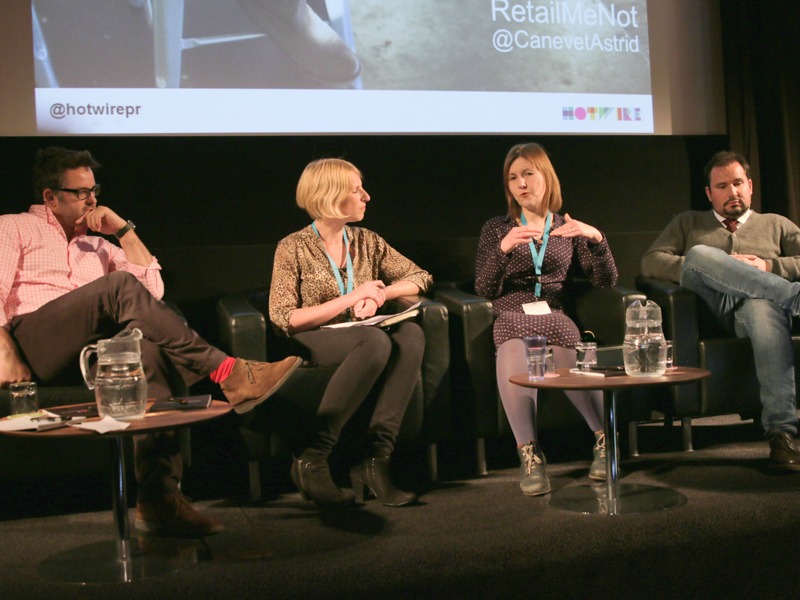Paul Holmes 19 May 2015 // 5:00PM GMT

LONDON—Social media is dying, but the British high street is alive and well and will still be relevant in 2020, attendees at the 2015 London In2Summit heard this afternoon, during a panel presented by UK-based technology PR specialist Hotwire.
Looking ahead to the year 2020, a trio of panelists looked at trends in retail, digital and social media, and virtual reality—but not before challenging the wisdom of predicting events even just five years down the road.
“Five years used to be a good horizon for looking forward,” said Astrid Canevet, senior manager of corporate communication for RetailMeNot, “but it is only seven years ago that the first iPhone was launched, five years ago was the first iPad. I think today it’s better to look two to three years ahead.”
As she looked ahead to the future of retailing in 2020, Canevet expressed confidence that the traditional “high street” would still be relevant, but predicted several broad trends: contextualization, personalization, interaction.
David Parkinson, head of digital for Africa, Middle East and India, Nissan, was in agreement. Commenting on the meme predicting the death of traditional retail at the hands of digital and social media: “It’s not the death of stores and the rise of digital; it’s the rise of digital and the revitalization of stores.”
But Parkinson offered a more skeptical view of the future of social media, not because social channels are going away but because of lack of interest, but because “it should be part of everything.”
He also warned that marketers rather than public relations people have been the most active users of—and investors in—social media, and told the audience that PR people needed to get over their reluctance to integrated paid social into their work.
Finally, Hotwire’s head of engagement John Brown focused on what might come next, once social media is completely integrated into marketing and communications, and got the room excited about the potential for virtual reality in PR.
Building on the idea that “try before you buy” was an exciting virtual reality application for retailers, he suggested potential for the new technology in public education and the not-for-profit sector—using VR to allow donors to visit a disaster site and witness the devastation—or in the public affairs arena (allowing people to see the new skyline before planning permission for a new skyscraper) as well as in brand experience.
Looking ahead to the year 2020, a trio of panelists looked at trends in retail, digital and social media, and virtual reality—but not before challenging the wisdom of predicting events even just five years down the road.
“Five years used to be a good horizon for looking forward,” said Astrid Canevet, senior manager of corporate communication for RetailMeNot, “but it is only seven years ago that the first iPhone was launched, five years ago was the first iPad. I think today it’s better to look two to three years ahead.”
As she looked ahead to the future of retailing in 2020, Canevet expressed confidence that the traditional “high street” would still be relevant, but predicted several broad trends: contextualization, personalization, interaction.
David Parkinson, head of digital for Africa, Middle East and India, Nissan, was in agreement. Commenting on the meme predicting the death of traditional retail at the hands of digital and social media: “It’s not the death of stores and the rise of digital; it’s the rise of digital and the revitalization of stores.”
But Parkinson offered a more skeptical view of the future of social media, not because social channels are going away but because of lack of interest, but because “it should be part of everything.”
He also warned that marketers rather than public relations people have been the most active users of—and investors in—social media, and told the audience that PR people needed to get over their reluctance to integrated paid social into their work.
Finally, Hotwire’s head of engagement John Brown focused on what might come next, once social media is completely integrated into marketing and communications, and got the room excited about the potential for virtual reality in PR.
Building on the idea that “try before you buy” was an exciting virtual reality application for retailers, he suggested potential for the new technology in public education and the not-for-profit sector—using VR to allow donors to visit a disaster site and witness the devastation—or in the public affairs arena (allowing people to see the new skyline before planning permission for a new skyscraper) as well as in brand experience.


































.jpg)





.tmb-135x100.jpg)


.tmb-135x100.jpg)








